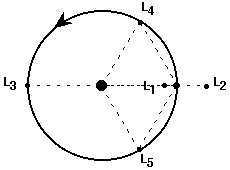the closest a fluid body can orbit to its primary without being
pulled apart by tidal forces. A solid body may
survive within the Roche limit if the tidal forces do not exceed its
structural strength.
The Roche limit is calculated with the equation
RL = 2.456*R*(p'/p)^(1/3)
where p' is the density of the planet, p is the density of the moon,
and R is the radius of the planet.
(more)
